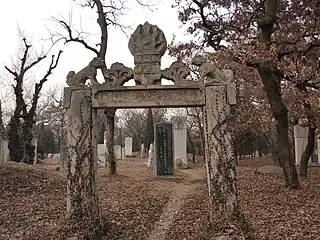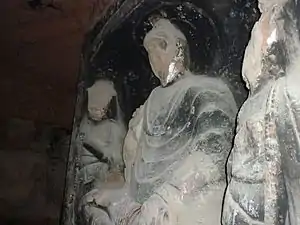
The Four Olds or the Four Old Things (simplified Chinese: 四旧; traditional Chinese: 四舊; pinyin: sì jiù) was a term used during the Cultural Revolution by the Red Guards in the People's Republic of China in reference to the pre-communist elements of Chinese culture they attempted to destroy. The Four Olds were: Old Ideas, Old Culture, Old Customs, and Old Habits (Chinese: Jiù Sīxiǎng 旧思想, Jiù Wénhuà 旧文化, Jiù Fēngsú 旧风俗, and Jiù Xíguàn 旧习惯).[2] The campaign to destroy the Four Olds began in Beijing on August 19, 1966 (the "Red August", during which a massacre also took place in Beijing[3]), shortly after the launch of the Cultural Revolution.[4]
Terminology
The term "Four Olds" first appeared on June 1, 1966, in Chen Boda's People's Daily editorial, "Sweep Away All Cow Demons and Snake Spirits", where the Old Things were described as anti-proletarian, "fostered by the exploiting classes, [and to] have poisoned the minds of the people for thousands of years".[5] However, which customs, cultures, habits, and ideas specifically constituted the "Four Olds" were never clearly defined.[6]
On August 8, the Central Committee of the Chinese Communist Party used the term at its 8th National Congress. The term was endorsed on August 18 by Lin Biao at a mass rally, and from there it spread to Red Flag magazine, as well as to Red Guard publications.[6]
Calls to destroy the "Four Olds" usually did not appear in isolation, but were contrasted with the hope of building the "Four News" (new customs, new culture, new habits, new ideas).[6] Newborn socialist things were said to struggle against the Four Olds.[7] The idea that Chinese culture was responsible for China's economic backwardness and needed to be reformed had some precedent in the May Fourth Movement (1919), and was also encouraged by colonial authorities during the Second Sino-Japanese War.[8]
Campaign to destroy the Four Olds
The campaign to Destroy the Four Olds and Cultivate the Four News (Chinese: 破四旧立四新; pinyin: Pò Sìjiù Lì Sìxīn) began in Beijing on August 19 during the "Red August".[5][9] Academic Alessandro Russo writes that the destruction of the Four Olds was an ambiguous campaign from the perspective of the Chinese Communist Party.[10] He argues that in a time of increasing political pluralization, the Party sought to channel student activism towards obvious class enemies and less relevant objectives to make it easier for the Party to contain the situation.[10]
The "re-naming" campaign

Across China, signs bearing old road names were vandalized.[11][12] The first things to change were the names of streets and stores: "Blue Sky Clothes Store" to "Defending Mao Zedong Clothes Store", "Cai E Road" to "Red Guard Road", and so forth.
In Beijing, the name of the road where the embassy of the Soviet Union was stationed was changed to "Anti-revisionism Road."[10] The Peking Union Medical College Hospital, founded in 1921 by the Rockefeller Foundation, was re-named "Anti-Imperialist Hospital".[13]
In Huangpu district of Shanghai, the city's commercial center, Red Guards tore down 93 percent of shop signboards (2,166 of 2,328), and renamed restaurants, schools and hospitals.[11] Red Guards also took Nanjing Road as their revolutionary headquarters in Shanghai, renaming it the "Anti-Imperialism Street".[11]
Many people across China also changed their given names to revolutionary slogans, such as Zhihong (志红, "Determined Red"), Jige (继革, "Following the Revolution") and Weidong (卫东, "Safeguard the Orient or Protect Mao").[6][12][14]
Public sites
The Cemetery of Confucius was attacked in November 1966, during the Cultural Revolution, when it was visited and vandalized by a team of Red Guards from Beijing Normal University, led by Tan Houlan.[15][16] The corpse of the 76th-generation Duke Yansheng was removed from its grave and hung naked from a tree in front of the palace during the desecration of the cemetery in the Cultural Revolution.[17]
The Chinese government stopped short of endorsing the physical destruction of products. In fact, the government protected significant archaeological discoveries made during the Cultural Revolution, such as the Mawangdui, the Leshan Giant Buddha and the Terracotta Army.[8]

Upon learning that Red Guards were approaching the Forbidden City, Premier Zhou Enlai ordered the gates shut and deployed the People's Liberation Army against the Red Guards. After this incident, Zhou attempted to create a more peaceful code of conduct for the Red Guards, with the support of cadres Tao Zhu, Li Fuchuan, and Chen Yi. This plan was foiled by the ultra-leftists Kang Sheng, Jiang Qing, and Zhang Chunqiao. Although many of Zhou's other initiatives to stem the destruction failed because of their or Mao's own opposition, he did succeed in preventing Beijing from being renamed "East Is Red City" and the Chinese guardian lions in front of Tian'anmen Square from being replaced with statues of Mao.[19]
In later stages of the campaign, examples of Chinese architecture were destroyed, classical literature and Chinese paintings were torn apart, and Chinese temples were desecrated.[6]
Personal harassment and private properties
Other manifestations of the Red Guard campaign included giving speeches, posting big-character posters, and harassment of people, such as intellectuals,[20] who defiantly demonstrated the Four Olds.[5] This escalated from accosting people in the streets due to their dress or hairstyle, to widespread murder, assault, arbitrary detention and the ransacking of private homes.[11] Red Guards broke into the homes of the wealthy and destroyed paintings, books, and furniture; all were items that they viewed as part of the Four Olds.[21]
Many artists and other cultural professionals were persecuted by vigilantes, although some cultural advances came about because of the period, including the integration of "new" western instruments and ballet into Peking opera.
Gallery
 This statue of the Yongle Emperor was originally carved in stone, and was destroyed in the Cultural Revolution. A metal replica is in its place.
This statue of the Yongle Emperor was originally carved in stone, and was destroyed in the Cultural Revolution. A metal replica is in its place. The remains of the 8th century Buddhist monk Huineng were attacked during the Cultural Revolution.
The remains of the 8th century Buddhist monk Huineng were attacked during the Cultural Revolution.
 A frieze damaged during the Cultural Revolution, originally from a garden house of a rich imperial official in Suzhou.
A frieze damaged during the Cultural Revolution, originally from a garden house of a rich imperial official in Suzhou. The Peking Union Medical College Hospital was re-named "Anti-Imperialist Hospital" by Red Guards.
The Peking Union Medical College Hospital was re-named "Anti-Imperialist Hospital" by Red Guards. A damaged statue of the Buddha.
A damaged statue of the Buddha.
Aftermath
Appraisal of damage
No official statistics have ever been produced by the Communist party in terms of reporting the actual cost of damage. By 1978, many stories of death and destruction caused by the Cultural Revolution had leaked out of China and became known worldwide.[24]
Restoration
Starting in the 1990s and continuing into the 21st century, there has been a massive rebuilding effort under way to restore and rebuild cultural sites that were destroyed or damaged during the Cultural Revolution. This has coincided with a resurgence in interest in, and demand for, Chinese cultural artifacts.
See also
- Burning of books and burying of scholars, 3rd century BC China
- 1989 Mao portrait vandalism incident, vandalism of the portrait of Mao Zedong
- Destruction of the Goddess of Democracy, as part of the 1989 Tiananmen Square massacre
- List of campaigns of the Chinese Communist Party
References
- ↑ "China's reluctant Emperor", The New York Times, Sheila Melvin, Sept. 7, 2011.
- ↑ Spence, Jonathan. The Search for Modern China. 2nd ed. New York: W.W. Norton & Co., 1999. p575
- ↑ Wang, Youqin (2001). "Student Attacks Against Teachers: The Revolution of 1966" (PDF). The University of Chicago. Archived (PDF) from the original on 2020-04-17.
- ↑ Law, Kam-yee. [2003] (2003). The Chinese Cultural Revolution Reconsidered: beyond purge and Holocaust. ISBN 0-333-73835-7
- 1 2 3 Li, Gucheng. A Glossary of Political Terms of The People's Republic of China. Chinese University Press. p. 427.
- 1 2 3 4 5 Lu, Xing. Rhetoric of the Chinese Cultural Revolution: The Impact on Chinese Thought, Culture, and Communication. University of South Carolina Press. pp. 61–62.
- ↑ Coderre, Laurence (2021). Newborn socialist things : materiality in Maoist China. Durham: Duke University Press. p. 2. ISBN 1-4780-2161-6. OCLC 1250021710.
- 1 2 Gao, Mobo (2008). The Battle for China's Past: Mao and the Cultural Revolution. Pluto Press. pp. 21–22.
- ↑ Kraus, Richard Curt (January 2012). "The Cultural Revolution: A Very Short Introduction". Oxford Academic. Retrieved 2023-06-22.
- 1 2 3 Russo, Alessandro (2020). Cultural Revolution and revolutionary culture. Durham: Duke University Press. p. 157. ISBN 1-4780-1218-8. OCLC 1156439609.
- 1 2 3 4 Howlett, Jonathan J. (August 2022). "Ordering the city: revolution, modernity and road renaming in Shanghai, 1949–1966". Urban History. 49 (3): 612–630. doi:10.1017/S0963926821000249. ISSN 0963-9268.
 This article incorporates text from this source, which is available under the CC BY 4.0 license.
This article incorporates text from this source, which is available under the CC BY 4.0 license. - 1 2 Ou, Jason (2016-05-13). "7 questions about China's Cultural Revolution answered". The Straits Times. ISSN 0585-3923. Retrieved 2023-06-22.
- ↑ "PEKING HOSPITAL TAKES BACK PRE-1949 NAME". The New York Times. 1985-06-09. ISSN 0362-4331. Retrieved 2023-06-22.
- ↑ Wren, Christopher S. (1984-12-09). "A PROBLEM FOR THE CHINESE: MILLIONS OF NAMESAKES". The New York Times. ISSN 0362-4331. Retrieved 2023-06-22.
- ↑ Ma, Aiping; Si, Lina; Zhang, Hongfei (2009), "The evolution of cultural tourism: The example of Qufu, the birthplace of Confucius", in Ryan, Chris; Gu, Huimin (eds.), Tourism in China: destination, cultures and communities, Routledge advances in tourism, Taylor & Francis US, p. 183, ISBN 978-0-415-99189-6
- ↑ Asiaweek, Volume 10
- ↑ Jeni Hung (April 5, 2003). "Children of confucius". The Spectator. Archived from the original on March 21, 2006. Retrieved 2007-03-04.
- ↑ "Tear Down the Palace!". China Heritage Quarterly. Archived from the original on 2023-03-10.
- ↑ Macfarquhar, Roderick; Schoenhals, Michael (2008). Mao's Last Revolution. Harvard University Press. pp. 118–119. ISBN 9780674027480.
- ↑ Wen, Chihua. Madsen, Richard P. [1995] (1995). The Red Mirror: Children of China's Cultural Revolution. Westview Press. ISBN 0-8133-2488-2
- ↑ Kort, Michael G. (1994). China Under Communism. Brookfield, MN: Millsbrook Press. p. 123. ISBN 9781562944506.
- ↑ Asiaweek, Volume 10. 1984. Archived from the original on April 27, 2016. Retrieved June 27, 2015.
- ↑ Jeni Hung (April 5, 2003). "Children of Confucius". The Spectator. Archived from the original on March 21, 2006. Retrieved March 4, 2007.
- ↑ Roberts, Richard H. [1995] (1995). Religion and the Transformations of Capitalism. Routledge publishing. ISBN 0-415-11917-0